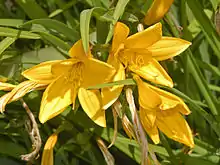Hemerocallis citrina
Hemerocallis citrina, common names citron daylily[2] and long yellow daylily, is a species of herbaceous perennial plant in the family Asphodelaceae.
| Hemerocallis citrina | |
|---|---|
 | |
| At the Jardin des Plantes, Paris | |
| Scientific classification | |
| Kingdom: | Plantae |
| Clade: | Tracheophytes |
| Clade: | Angiosperms |
| Clade: | Monocots |
| Order: | Asparagales |
| Family: | Asphodelaceae |
| Subfamily: | Hemerocallidoideae |
| Genus: | Hemerocallis |
| Species: | H. citrina |
| Binomial name | |
| Hemerocallis citrina Baroni[1] | |
Description
Hemerocallis citrina can reach a height of 90–120 centimetres (35–47 in). It has bright green, linear arching leaves about 40 cm long. Flowers are lemon yellow, trumpet-shaped, showy and very fragrant, about 15 centimetres (5.9 in) in diameter. They bloom from June to July. Long yellow day lily is cultivated in Asia for its edible flowers.
Distribution and habitat
This species is native to eastern Asia and China. It grows in forest margins, grassy fields and slopes, at an elevation of 0–2,000 metres (0–6,562 ft) above sea level.
Other uses
The tubers, inflorescences, buds and flowers can all be cooked and eaten. Dried or fresh flowers, sometimes called "gum jum" or "golden needles" (金針 in Chinese; pinyin: jīn zhēn) or as huánghuācài (黃花菜, literally "yellow flower vegetable") are used in Chinese cuisine for dishes including hot and sour soup, daylily soup (金針花湯), Buddha's delight, and moo shu pork. The dried flowers are also used in Japanese, Korean, Thai, and Vietnamese cooking.[3][4]
References
- "Hemerocallis citrina Baroni". Plants of the World Online. Royal Botanic Gardens, Kew. Retrieved 16 January 2020.
- "Hemerocallis citrina". Natural Resources Conservation Service PLANTS Database. USDA. Retrieved 19 January 2016.
- Cooking with Lily Flower or Golden Needles
- Hemerocallis citrina
- Missouri Botanical Garden
- Tropicos
- The Plant List
- Plants for a future
- Flora of China Editorial Committee. 2000. Flora of China (Flagellariaceae through Marantaceae). 24: 1–431. In C. Y. Wu, P. H. Raven & D. Y. Hong Fl. China. Science Press & Missouri Botanical Garden Press, Beijing & St. Louis.